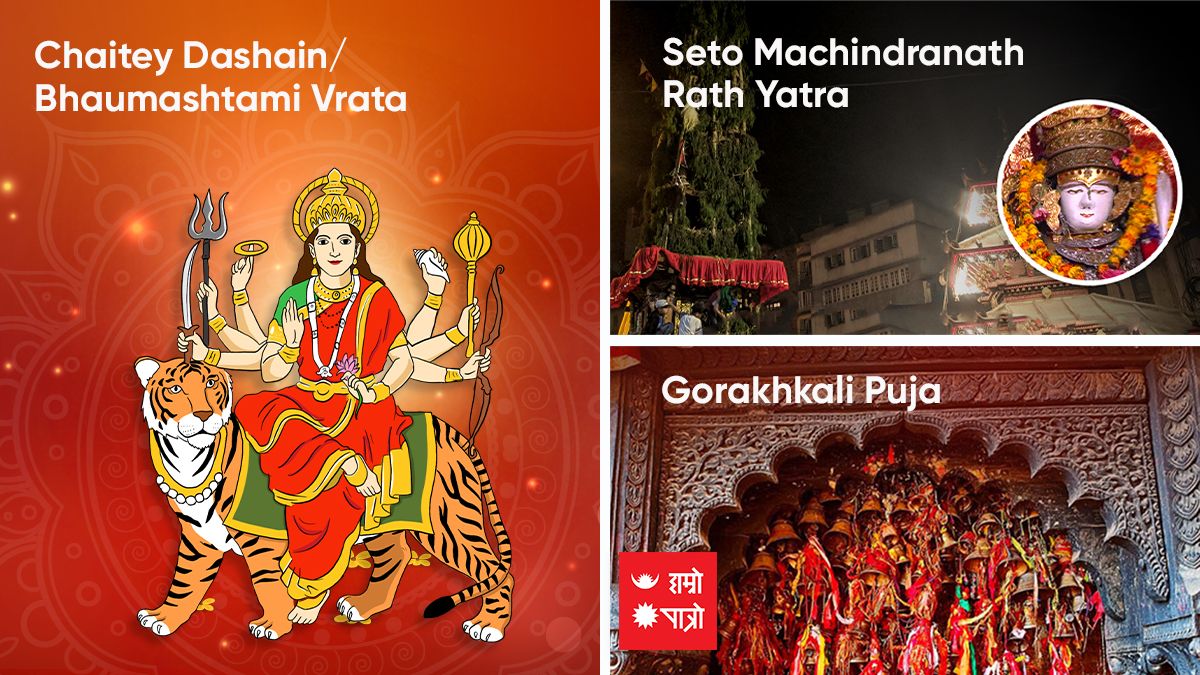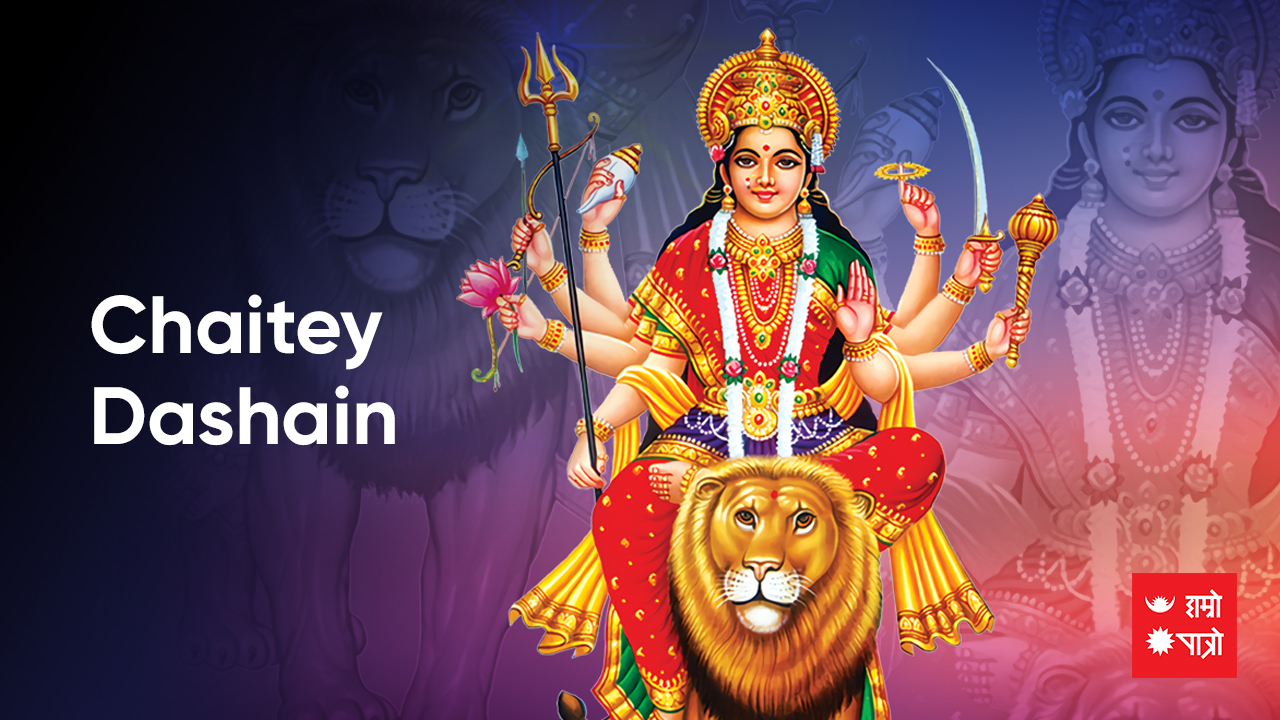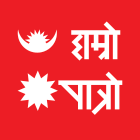Upcomming Events
-
19Paush
-
21PaushGuru Gobinda Singh Jayanti 2 days remaning
-
23PaushAraniko Smriti Day 4 days remaning
-
24PaushNepal Astrology Council Establishment Day 5 days remaning
-
27PaushPrithivi Jayanti/Rashtriya Ekata Diwas/Gorakhkali Puja 8 days remaning
-
29PaushNational Bhakka Day 10 days remaning
-
30PaushShattila Ekadashi 11 days remaning
-
1MaghMakar Sankranti/Ghiu chaku khane Din/Uttarayan Arambha 12 days remaning
-
2MaghNational Earthquake Safety Day/Pradosh Vrata 13 days remaning
-
5MaghSonam Lhochhar/Shree Ballav Jayanti 16 days remaning
-
8MaghTilkunda Chauthi 19 days remaning
-
9MaghBasanta Panchami vrata/Saraswati Pooja 20 days remaning
-
10MaghSkanda Sasti/Achala Saptami/International Day of Education 21 days remaning
-
11MaghGorakhkali Puja/World Leprosy Day 22 days remaning
-
12MaghInternational Custom Day 23 days remaning
-
13MaghDron Nawami 24 days remaning
-
15MaghBhima Ekadashi Vrata 26 days remaning
-
16MaghSahid Diwas/Pradosh Vrata 27 days remaning
-
18MaghShree Swasthani Brata Samapti/Poornima Wrata 29 days remaning
-
19MaghWorld Wetlands Day 30 days remaning
-
21MaghWorld Cancer Day 32 days remaning
-
25MaghRavisaptami Vrata 36 days remaning
-
26MaghGorakhkali Puja 37 days remaning
-
28MaghInternational Day of Women and Girls in Science/Safer Internet Day 39 days remaning
-
1FalgunKumbha Sankranti/Bijaya Ekadashi Vrata/World Radio Day 41 days remaning
-
2FalgunShani Pradosh Vrata/Valentine's Day 42 days remaning
-
3FalgunMaha-Shivaratri / Army Day/Silachahre Puja 43 days remaning
-
6FalgunGyalpo Lhosar 46 days remaning
-
7FalgunPrajatantra Diwas / Election Day 47 days remaning
-
8FalgunWorld Day of Social Justice 48 days remaning
-
9FalgunInternational Mother Language Day 49 days remaning
-
12FalgunBhaumashtami Wrata/Gorakhkali Puja 52 days remaning
-
15FalgunAmalaki Ekadashi Vrata/World NGO Day 55 days remaning
-
17FalgunPradosh Vrata/Zero Discrimination Day 57 days remaning
-
18FalgunFagu Poornima / Holi/Poornima Vrata 58 days remaning
-
19FalgunFagu Poornima (Terai)/Khandagras Chandra Grahan/World Wildlife Day 59 days remaning
-
20FalgunTel Lagaune Ra Aapko Mujura Khane Din 60 days remaning
-
24FalgunInternational Womens Day 64 days remaning
-
27FalgunGorakhkali Puja 67 days remaning
-
1ChaitraMeen Sankranti/Paapmochini Ekadashi Brata/World Consumer Rights Day 71 days remaning
Jyotish
-
Jyotish Krishna Prasad Bhandariउपप्राध्यापक (Asst. professor of Sanskrit) नेपा�...
-
Jyotish Purushottam Ghimireनेपाल संस्कृत विश्वविद्यालय, �...
-
Jyotish Vaman Sapkotaशिक्षा - व्याकरणाचार्य, पौरोही...
-
 Jyotish Dharmendra Krishna Paudelशास्त्री धर्मेन्द्र कृष्ण पौ�...
Jyotish Dharmendra Krishna Paudelशास्त्री धर्मेन्द्र कृष्ण पौ�...
-
Jyotish Mohan Ghimireसम्पुर्णानन्द संस्कृत विश्वव...
-
Jyotish Narayan Prasad Gautamगुरुकुल शिक्षा प्रणालीबाट ज्�...
-
Jyotish Pandit Mukunda Nepalज्योतिष पण्डित मुकुन्द नेपाल�...
-
Jyotish Smarika Acharyaबाल्मीकि बिद्यापिठ बाट ज्योत�...
-
Jyotish Damodar Poudelनेपाल संस्कृत विश्व बिद्यालय�...
-
Jyotish Amrit Paudelवाराणसीकै सम्पूर्णानन्द संस्...
-
Jyotish Khageshwor Subediगुरुकुल पद्दति बाट ज्योतिषीय �...
-
Jyotish Dipendra Khatiwadaसम्पुर्णानन्द संस्कृत बिश्वब...
-
Jyotish Narayan Prasad Bhandariज्योतिषका उप-प्राध्यापक (lecturer of A...
-
 Jyotish Kuresh Pandey११ वर्षको अनुभवसहित विभिन्न ध�...
Jyotish Kuresh Pandey११ वर्षको अनुभवसहित विभिन्न ध�...
-
Jyotish Deepak Prasad Kafleसम्पूर्णानन्द संस्कृत विश्वव...
-
 Jyotish Mukunda Sharmaस्वाध्याय, सत्सङ्ग र सदाचारजस�...
Jyotish Mukunda Sharmaस्वाध्याय, सत्सङ्ग र सदाचारजस�...
-
Jyotish Damodar Kaushikज्योतिष र व्याकरण विषयमा आचार�...
-
Jyotish Hamro patroनेपाल संस्कृत विश्वविद्यालय �...
-
Jyotish Ghanashyam Pokharelनेपाल संस्कृत विश्वविद्यालयब...
Hororscope
चैत शुक्ल अष्टमी
Chaitey Dashain । Bhaumashtami Vrata । Seto Machindranath Rath Yatra । Gorakhkali Puja

Chaitey Dashain
Replica of the Main Dashain
On the one hand, this year's farewell is on the edge as Chaitey Dashain knocks, and on the other hand, the New Year's roan is hitting the bell. Dashain, the great festival of Nepali people and a festival carrying cultural significance famous as Navratri. This Chaitey Dashain is a reflection of the main Dashain that occurs during Asoj, Kartik of Bikram Sambat calendar. According to the myths, in the past, the main Dashain used to fall in Chait but due to the dry seasons and frequently occurring droughts later Dashain was shifted to Asoj Kartik (Middle of the year).
Whatever it is, the roan of Chaitey Dashain is not an inch less than the main Dashain. Asian nations like India, Bangladesh and Myanmar observes this Dashain as Chaitra Navaratri.
Chaitra Shukla asthami
Dashain falls in Dashami tithi (tenth day) but here at Nepal we commemorate Chaitey Dashain on Asthami (Eight Day) because this eight-day is a day of scarifying our wills, desires and also offering animals to Goddesses Bhawani. Dakshinkali, Shovavagwati, Maitidevi, RaktaKali, Sankata, Guheswori of Kathmandu valley is filled with devotees in this day, Nepal army also commemorates this day in their own way.
From ancient times, the process of offering sacrifices has been going on in Kathmandu Valley. Outside the valley, at Bhagwati temples and Shakti Peethas, the devotees observe prayers and congregations. In some Bhagwati temples, there is a grand fair. Lord Rama returned back from his 14 years of exile, on this day. This day is the purest depiction of the truth against the false, light against darkness and humanity against inhumane attributes.
Falsehood and inequality may decrease, truth and righteousness must always prevail. The importance of truth lies more than falsehood. Hail the lord!!!!
Bhaumasthami
Chaitra Dashain means the Dashain that falls in Chaitra. Navratri is worshiped in this Dashami as in the main Dashain. Even though it is called Chaite Dashain, today's tithi is Ashtami. It may be that the eighth day of Chaitra Navaratri has been brought into vogue as offerings, food, and feasts.
This is also practical because the practice of Tika is not given much importance in Chaite Dashain. After this, considering Ashtami as Dashain, it becomes easy to have a pleasant atmosphere for all the family and friends.
In this way, Ashtami Tithi is the day of Dashain fast, but it is also customary to fast Bhoomashtami on this day. Followers of Sanatan Dharma can celebrate and remember every festival in their way. The practice of fasting for spiritual fruits on this day is unique in itself.
In Bhaumashtami fast, especially worship of Mars and planetary peace is also done. There are many fruits of worshiping Shakti on the eighth day. There is a tradition of worshiping and adoring Gorakhkali Bhagwati in Bhaumashtami, especially in the temple of Bhagwati Gorakhkali in Gorkha.
As in other vrata, it is customary to get up in the morning to take a bath, sing hymns, worship and study the holy books and meditate. Good luck to everyone on this year's Bhoomshtami.
Seto Machindranath Rathyatra commences: Kathmandu's god of rain
Avalokitesvara, meaning the god of totality Between Asan and Indrachowk in Kathmandu, there is a temple of Janabaha Dya, which is considered a historical temple established in the 10th century.This compassionate Janabaha Dya, Machhindranath is also called Avalokitesvara, Avalokitesvara, meaning the god of totality. On the other hand, Avalokitesvara is also understood in Sanskrit as the deity of the lotus flower. Every dimension of Bodhisattva coincides with Avalokitesvara.
Ancient tradition of the Kathmandu civilization
As we all know, Kathmandu is not only a city but also a civilization.
Seto Machhindranath i.e.Avalokitesvara is one among the several ancient tradition and procession of this ancient Kathmandu. Machindranath, the God who sees his devotees back on earth, loves them and shares their love. Although this procession, which is believed to have started from the 6th century, has been widely used since the 17th century.
This procession starts on the 8th day of Chaula in the sixth month of Nepal Samvat and ends on the 10th day.
Janabaha Dya: Jatra of Seto Machhindranath as a procession It is customary to carry the statue of Machhindranath in a chariot every year.
History of the seto Machindranath Rathyatra
White-skinned and half-closed deities command King Yaksha Malla to build a temple for them to visit in Kalimati and Bagmati. Doing so is believed to bring happiness and the gift of long life to the people of the kingdom. Starting on the eighth day of the month of Chaitra, this rath yatra is a three-day festival that correlates from the time of King Yaksha Malla.
You may be surprised that the beginning of this journey may have taken place in the month of Poush, but this is the truth. Every year on the eighth day of Shukla Paksha in the month of Poush, Machhindranath's chariot is taken to the Machhindranath temple and cleaned with milk, ghee, etc. The living goddess Kumari also participates in this program. In this way, the chariot or so-called khata, which has been prepared in the month of Poush, is used in this procession of Chaitra.
I wish all the best for the journey of Seto Machhindranath in the year 2081 BS.
Gorakhkali Puja
Baba Gorakh and Gorakhkali vagwati are very important in Nepali history. The meeting between Prithvi Narayan Shah and Baba Gorakh, the vomit that fell on the feet of Prithvi Narayan Shah and the auspiciousness given by Baba Gorakh to Prithvi Narayan Shah that there will be victory wherever he bows is the reason for the energy and strength of Nepal's unification.
The glory of Gorakhnath Baba, a unique devotee of Baba Machindranath, is special in the Sanatan community of Nepal, India and all over the world.Gorkha, the district of origin of Shah dynasty kings adjacent to the name of Baba Gorakh, and Gorakhkali temple have special importance in the former royal family of Nepal. It should be remembered that in the history of Baba Gorakh, the Gorakh palace and dynasty as well as the Gorakh temple in Pashupati's mrigasthali forest and Baba's 15-year meditation there are also connected.
The Gorkha temple of Mrigasthali is in a state of neglect due to lack of protection and management.
In the Gorkha Darbar area is the shrine of Gorakhkali Devi. This Peetha is considered as the Kool Devi of the Shah Dynasty. It is customary to worship Gorkhali on Paush Krishna Ashtami. Today, a special puja is performed at the Gorakhkali temple in Gorkha.
It has been a tradition for hundreds of years to bring Jamara to Kathmandu on Phulpati day in this Gorakhkali temple. In the post-republic years, such customs have not been given much attention, although the importance of Baba Gorakh and Gorakhkali Devi in the protection of Nepalese land has been incomparable.
Nepali people need more blessings of Baba Gorakh and Gorakhkali Devi to protect cows.
Gorakh Sandesh (Message)
Gorakh message
Guru Gorakhnath says - "The journey of the temples and shrines is Suno Yatra" meaning the pilgrimage of the temples etc. are spiritually meaningless, equal to zero, soulless – unless we are able to spread love to every being in this cosmos.
देवल जात्रा सुंनि जात्रा, तीरथ जात्रा पाणीं ।
अतीत जात्रा सुफल जात्रा, बोलै अमृत वाणी ।।
Yes, the role of temples is very important in terms of religion and culture, but if there is a pilgrimage but there is no faith, there is no emotion and there is no devotion, then what is the use of just doing a "deval pilgrimage"? Do not worship people who worship idols! Run to temple but can't make the house a temple! Worshiping the deity of the temple but unable to awaken divinity in himself! Offering fruit, offerings, etc. to the deity made of stone in a small area and complex, but not accepting that the divinity resides in every human, animal and bird! And unable to serve! Seeing such religious pretentiousness, Guru Gorakhnath made a sharp satire in Khadi language (Prakrit language, folk language, rural language). Glory be to Baba Gorakhnath and Gorakhkali Bhagwati forever.
Infinite love of Gorakhkali Puja.
Suyog Dhakal
Upcomming Events
-
19Paush
-
21PaushGuru Gobinda Singh Jayanti 2 days remaning
-
23PaushAraniko Smriti Day 4 days remaning
-
24PaushNepal Astrology Council Establishment Day 5 days remaning
-
27PaushPrithivi Jayanti/Rashtriya Ekata Diwas/Gorakhkali Puja 8 days remaning
-
29PaushNational Bhakka Day 10 days remaning
-
30PaushShattila Ekadashi 11 days remaning
-
1MaghMakar Sankranti/Ghiu chaku khane Din/Uttarayan Arambha 12 days remaning
-
2MaghNational Earthquake Safety Day/Pradosh Vrata 13 days remaning
-
5MaghSonam Lhochhar/Shree Ballav Jayanti 16 days remaning
-
8MaghTilkunda Chauthi 19 days remaning
-
9MaghBasanta Panchami vrata/Saraswati Pooja 20 days remaning
-
10MaghSkanda Sasti/Achala Saptami/International Day of Education 21 days remaning
-
11MaghGorakhkali Puja/World Leprosy Day 22 days remaning
-
12MaghInternational Custom Day 23 days remaning
-
13MaghDron Nawami 24 days remaning
-
15MaghBhima Ekadashi Vrata 26 days remaning
-
16MaghSahid Diwas/Pradosh Vrata 27 days remaning
-
18MaghShree Swasthani Brata Samapti/Poornima Wrata 29 days remaning
-
19MaghWorld Wetlands Day 30 days remaning
-
21MaghWorld Cancer Day 32 days remaning
-
25MaghRavisaptami Vrata 36 days remaning
-
26MaghGorakhkali Puja 37 days remaning
-
28MaghInternational Day of Women and Girls in Science/Safer Internet Day 39 days remaning
-
1FalgunKumbha Sankranti/Bijaya Ekadashi Vrata/World Radio Day 41 days remaning
-
2FalgunShani Pradosh Vrata/Valentine's Day 42 days remaning
-
3FalgunMaha-Shivaratri / Army Day/Silachahre Puja 43 days remaning
-
6FalgunGyalpo Lhosar 46 days remaning
-
7FalgunPrajatantra Diwas / Election Day 47 days remaning
-
8FalgunWorld Day of Social Justice 48 days remaning
-
9FalgunInternational Mother Language Day 49 days remaning
-
12FalgunBhaumashtami Wrata/Gorakhkali Puja 52 days remaning
-
15FalgunAmalaki Ekadashi Vrata/World NGO Day 55 days remaning
-
17FalgunPradosh Vrata/Zero Discrimination Day 57 days remaning
-
18FalgunFagu Poornima / Holi/Poornima Vrata 58 days remaning
-
19FalgunFagu Poornima (Terai)/Khandagras Chandra Grahan/World Wildlife Day 59 days remaning
-
20FalgunTel Lagaune Ra Aapko Mujura Khane Din 60 days remaning
-
24FalgunInternational Womens Day 64 days remaning
-
27FalgunGorakhkali Puja 67 days remaning
-
1ChaitraMeen Sankranti/Paapmochini Ekadashi Brata/World Consumer Rights Day 71 days remaning
Jyotish
-
Jyotish Krishna Prasad Bhandariउपप्राध्यापक (Asst. professor of Sanskrit) नेपा�...
-
Jyotish Purushottam Ghimireनेपाल संस्कृत विश्वविद्यालय, �...
-
Jyotish Vaman Sapkotaशिक्षा - व्याकरणाचार्य, पौरोही...
-
 Jyotish Dharmendra Krishna Paudelशास्त्री धर्मेन्द्र कृष्ण पौ�...
Jyotish Dharmendra Krishna Paudelशास्त्री धर्मेन्द्र कृष्ण पौ�...
-
Jyotish Mohan Ghimireसम्पुर्णानन्द संस्कृत विश्वव...
-
Jyotish Narayan Prasad Gautamगुरुकुल शिक्षा प्रणालीबाट ज्�...
-
Jyotish Pandit Mukunda Nepalज्योतिष पण्डित मुकुन्द नेपाल�...
-
Jyotish Smarika Acharyaबाल्मीकि बिद्यापिठ बाट ज्योत�...
-
Jyotish Damodar Poudelनेपाल संस्कृत विश्व बिद्यालय�...
-
Jyotish Amrit Paudelवाराणसीकै सम्पूर्णानन्द संस्...
-
Jyotish Khageshwor Subediगुरुकुल पद्दति बाट ज्योतिषीय �...
-
Jyotish Dipendra Khatiwadaसम्पुर्णानन्द संस्कृत बिश्वब...
-
Jyotish Narayan Prasad Bhandariज्योतिषका उप-प्राध्यापक (lecturer of A...
-
 Jyotish Kuresh Pandey११ वर्षको अनुभवसहित विभिन्न ध�...
Jyotish Kuresh Pandey११ वर्षको अनुभवसहित विभिन्न ध�...
-
Jyotish Deepak Prasad Kafleसम्पूर्णानन्द संस्कृत विश्वव...
-
 Jyotish Mukunda Sharmaस्वाध्याय, सत्सङ्ग र सदाचारजस�...
Jyotish Mukunda Sharmaस्वाध्याय, सत्सङ्ग र सदाचारजस�...
-
Jyotish Damodar Kaushikज्योतिष र व्याकरण विषयमा आचार�...
-
Jyotish Hamro patroनेपाल संस्कृत विश्वविद्यालय �...
-
Jyotish Ghanashyam Pokharelनेपाल संस्कृत विश्वविद्यालयब...
Hororscope
Liked by:


















 Mesh
Mesh Brish
Brish Mithun
Mithun Karkat
Karkat  Singha
Singha  Kanya
Kanya Tula
Tula Brischik
Brischik Dhanu
Dhanu  Makar
Makar  Kumbha
Kumbha Meen
Meen